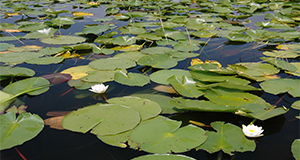Abstract
This publication profiles common wetland and aquatic plants of Lake Apopka. Written by Carrie Reinhardt Adams, Laura Reynolds, Charles W. Martin, Christine Rohal, Ryan Goebel, and Jodi Slater, and published by the UF/IFAS Environmental Horticulture Department, January 2023.
References
Bowen, P., Slater, J., 2016. Lake Apopka North Shore Biological Assessment for Phase 2 West Active Management Phase. St. Johns River Water Management District.
Chesnut, T.L., Barman, E.H., 1974. Aquatic vascular plants of Lake Apopka, Florida. Fla. Sci. 37, 60-64.
Clugston, J.P., 1963. Lake Apopka, Florida, A changing lake and its vegetation. Q. J. Fla. Acad. Sci. 26, 168-174.
Conrow, R., Lowe, E.F., Coveney, M.F., Rauschenberger, R.H., Masson, G., 2011. Restoration of Lake Apopka's North Shore Marsh: High Hopes, Tough Times, and Persistent Progress, in: Elliott, J.E., Bishop, C.A., Morrissey, C.A. (Eds.), Wildlife Ecotoxicology. Springer New York, New York, NY, pp. 189-211. https://doi.org/10.1007/978-0-387-89432-4_6
Center, T.D., Cuda, J.P., Grodowitz, M., Minteer, C., 2022. Alligatorweed Flea Beetle Agasicles hygrophila Selman and Vogt (Coleoptera: Chrysomelidae: Halticinae) (Electronic Data Information Source (EDIS) No. Publication ##EENY 462). University of Florida Institute of Food and Agricultural Sciences.
Coveney, M.F., Lowe, E.F., Battoe, L.E., Marzolf, E.R., Conrow, R., 2005. Response of a eutrophic, shallow subtropical lake to reduced nutrient loading. Freshw. Biol. 50, 1718-1730. https://doi.org/10.1111/j.1365-2427.2005.01435.x
Dunne, E.J., Coveney, M.F., Hoge, V.R., Conrow, R., Naleway, R., Lowe, E.F., Battoe, L.E., Wang, Y., 2015. Phosphorus removal performance of a large-scale constructed treatment wetland receiving eutrophic lake water. Ecol. Eng. 79, 132-142. https://doi.org/10.1016/j.ecoleng.2015.02.003
Dunne, E.J., Coveney, M.F., Marzolf, E.R., Hoge, V.R., Conrow, R., Naleway, R., Lowe, E.F., Battoe, L.E., 2012. Efficacy of a large-scale constructed wetland to remove phosphorus and suspended solids from Lake Apopka, Florida. Ecol. Eng. 42, 90-100. https://doi.org/10.1016/j.ecoleng.2012.01.019
Enloe, S. F., L. A. Gettys, J. Leary, and K. A. Langeland. 2012. Hydrilla management in Florida Lakes. (Electronic Data Information Source (EDIS) Publication #SS-AGR-361). University of Florida, Institute of Food and Agricultural Resources, Gainesville, FL. https://doi.org/10.32473/edis-ag370-2012
Gettys, L. A. and S. F. Enloe. 2016. Hydrilla: Florida's worst submersed weed. (Electronic Data Information Source (EDIS) Publication #SS-AGR-400). University of Florida, Institute of Food and Agricultural Resources, Gainesville, FL
FISC, 2019. List of Invasive Plant Species. Florida Invasive Species Council.
Florida Natural Areas Inventory (FNAI), 2010. FNAI Natural Community Classification Guide. Florida Natural Areas Inventory, Tallahassee, FL.
Iannone III, B.V., Bell, E.C., Carnevale, S., Hill, J.E., McConnel, J., Main, M., Enloe, S.F., Johnson, S.A., Cuda, J.P., Baker, S.M., Andreu, M., 2021. Standardized Invasive Species Terminology for Effective Outreach Education (Electronic Data Information Source (EDIS) No. FOR370/FR439:). UF/IFAS, Gainesville, FL. https://doi.org/10.32473/edis-fr439-2021
Ji, G., Havens, K., 2019. Periods of Extreme Shallow Depth Hinder but Do Not Stop Long-Term Improvements of Water Quality in Lake Apopka, Florida (USA). Water 11, 538. https://doi.org/10.3390/w11030538
Lieurance, D. and Gettys, L. 2019. Lost in the Weeds?: A Comprehensive Guide to Florida's Many Non-Native Plant Lists. (Electronic Data Information Source (EDIS) No. Publication #SS-AGR-436). University of Florida Institute of Food and Agricultural Sciences. https://doi.org/10.32473/edis-ag436-2019
Looby, A., Reynolds, L.K., Adams, C.R., Martin, C.W., 2021a. Submerged aquatic vegetation patch size affects fish communities in a turbid-algal lake. Front. Conserv. Sci. 2. https://doi.org/10.3389/fcosc.2021.657691
Looby, A., Reynolds, L.K., Adams, C.R., Walsh, S.J., Martin, C.W., 2021b. Submerged aquatic vegetation habitat use of age-0 Florida bass Micropterus floridanus. Environ. Biol. Fishes 104, 947-958. https://doi.org/10.1007/s10641-021-01126-3
Moore, K., Fisher, L., Della Torre III, C., Gettys, L., 2015. Native Aquatic and Wetland Plants: Duck Potato, Sagittaria lancifolia. (Electronic Data Information Source (EDIS) No. Publication #SS-AGR-399). University of Florida Institute of Food and Agricultural Sciences.
Murphy, S., 2005. Assessment of fish and plant communities in Lake Apopka, Florida (M.S. Thesis). University of Florida.
Reynolds, L., Adams, C.R., Latimer, E., Martin, C.W., Rohal, C., Slater, J., 2020. A Comparison of Planting Techniques for Submerged Aquatic Vegetation (Electronic Data Information Source (EDIS) No. Publication #SL472). University of Florida Institute of Food and Agricultural Sciences. https://doi.org/10.32473/edis-ss685-2020
Reynolds, L.K., Rohal, C.B., Scheffel, W.A., Adams, C.R., Martin, C.W., Slater, J., 2021. Submerged Aquatic Vegetation Species and Populations Within Species Respond Differently to Environmental Stressors Common in Restorations. Environ. Manage. 68, 477-490. https://doi.org/10.1007/s00267-021-01517-3
Rohal, C., Reynolds, L.K., Reinhardt Adams, C., Martin, C., 2020. Pondweeds of Florida (Electronic Data Information Source (EDIS) No. Publication #SL473). University of Florida, Institute of Food and Agricultural Resources, Gainesville, FL. https://doi.org/10.32473/edis-ss686-2020
Rohal, C.B., Reynolds, L.K., Adams, C.R., Martin, C.W., Latimer, E., Walsh, S.J., Slater, J., 2020. Biological and practical tradeoffs in planting techniques for submerged aquatic vegetation. Aquat. Bot. 103347. https://doi.org/10.1016/j.aquabot.2020.103347
Slagle, Z.J., Allen, M.S., 2018. Should we plant macrophytes? Restored habitat use by the fish community of Lake Apopka, Florida. Lake Reserv. Manag. 34, 296-305. https://doi.org/10.1080/10402381.2018.1443179
Tootoonchi, M., Gettys, L.A., Bhadha, J.H., 2019. SS-AGR-437/AG437: Tapegrass, Eelgrass, or Wild Celery (Vallisneria americana Michaux): A Native Aquatic and Wetland Plant ((Electronic Data Information Source (EDIS) No. #SS-AGR-437). https://doi.org/10.32473/edis-ag437-2019
UF/IFAS Center for Aquatic and Invasive Plants, 2021. Plant Directory [WWW Document]. URL https://plants.ifas.ufl.edu/plant-directory/ (accessed 2.18.21).
UF/IFAS Lakewatch Program, 2020. Lakewatch Data. University of Florida.
United States Government Publishing Office. 2022. "The Federal Noxious Weed Act." Accessed October 26,2022. https://www.govinfo.gov/content/pkg/STATUTE-88/pdf/STATUTE-88-Pg2148.pdf
USDA, NRCS, 2018. The PLANTS Database [WWW Document]. URL http://plants.usda.gov/ (accessed 2.18.21).
Wells, B., Minteer, C., 2022. Alligatorweed Stem Borer (suggested common name) Arcola malloi Pastrana (Insecta: Lepidoptera: Pyralidae: Phycitinae) Electronic Data Information Source (EDIS) No. Publication ##EENY-764). University of Florida Institute of Food and Agricultural Sciences. https://doi.org/10.32473/edis-in1300-2020

